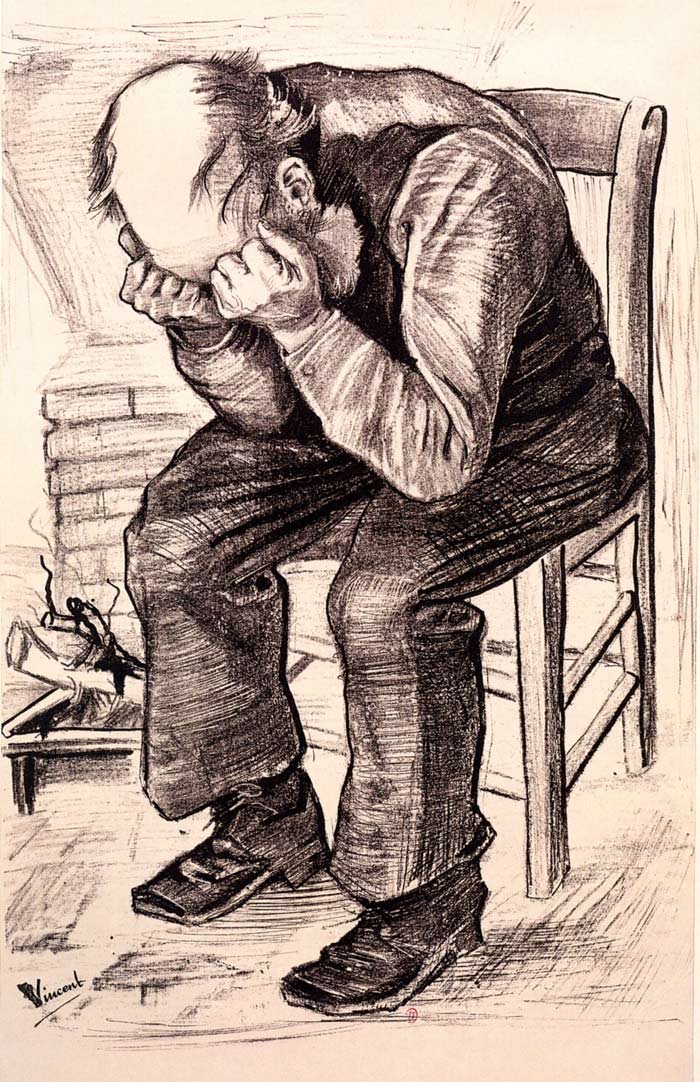Article by Anders E. Johnson
From the collection of Van Gogh’s earlier works, the drawing Worn Out, completed in 1882, resonates the earnestness of the beloved artist Vincent Van Gogh.

Worn Out by Vincent Van Gogh
1882, pencil on paper
Van Gogh Museum, Amsterdam, Netherlands
We are confronted with a sketch of a Dutch farmer peasant. Drawn with pencil on paper, Van Gogh employed light strokes of graphite as well as bold lines to define the edges of the chair and the farmer’s pants. Crosshatching is also visible throughout the piece, giving a sense of texture, especially as seen on the dirt floor surface and the clothes. The entire composition is structured vertically with the main element being the man centered in the foreground in a rectangular fashion.
We are greeted abruptly or perhaps better we that we are intruding upon an old peasant farmer hailing from presumably around the area of Haag, Netherlands (the place where Van Gogh was during this period in his artistic career). He is seated in a wooden chair, bent low in a humbling, yet restful position with his head resting atop his folded wrists. The farmer is seated near a fireplace with a fire which appears to have been just lit. Without a doubt, save the work’s title, the image in front of us demonstrates a moment of relief after a laborious day’s work on the farmland of the Dutch.
Peasant farm life assumes the daily tasks of tending to animals, ploughing, painting; fieldwork of the like. A farmer grows and cultivates the earth to provide nutrition for his fellow man. Like the hardworking farmer, the painter Vincent Van Gogh is an archetype of the suffering artist. His career spanned just nearly ten years, and within that period he completed thousands of artworks. Worn Out was completed earlier in his career. During this time, Van Gough arduously employed himself to the study of drawing. He would travel through the Dutch country side with paper and pencil in hand, and took a good portion of the day drawing the village people doing their daily chores. The style of these drawings falls under realism, since each subject is depicted in a natural, realistic form without addition of whimsical elements to distract the eye or deter the imagination away from the blunt force of real life.
Vincent Van Gogh suffered. He was not successful the least in his lifetime, yet besides only selling one painting, he continued to draw and paint not for anyone else, but for, as he put it, “art’s sake”. Drawing acted as the barebones to his artistic expressions. The long lines and short dots and dashes seen in his drawings also dance in his colorful oil paintings.
The bearded farmer in Worn Out is almost like a portrait of Van Gogh himself. The fine attention to detail seen in the harmonious mixture of lines, dots, smudges, and hatching, greets us with the prancing artistic thoughts, decisions, and talent which Vincent possessed. As the farmer toiled in the cold of winter, winds of autumn, wetness of spring, and scorching heat of summer in order to plough, plant, water, gather, and distribute to the benefit of mankind, so did likewise Vincent Van Gogh, and this ‘making art for art’s sake’ is the foundation of any artist worldwide.




